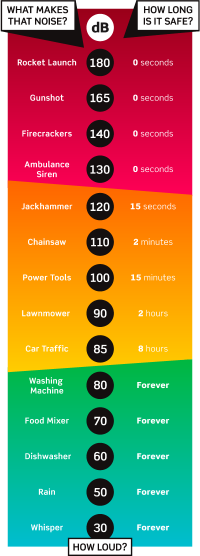What is noise-induced hearing loss?

Download a longer version of this article
Noise-induced hearing loss (NIHL) is a type of hearing loss caused by exposure to excessive sound levels. It commonly happens due to repeated exposure over a long period of time (years) in the workplace, or can arise in a recreational setting e.g. attendance at many loud concerts or use of loud power tools at home.
A single event e.g. an explosion can also cause NIHL if the intensity (volume) is loud enough.
How loud is too loud?
With so many noises around us, it can be difficult to know what is too loud. Sound is measured in decibels (dB). Research has shown that sounds louder than 85 dB can cause damage to our hearing; but it’s not just how loud a sound is, but also how long you are exposed to it.
The louder a sound, the less time it takes to damage your hearing. Sounds at 85 dB are considered safe for 8 hours for most people.
For each 3 dB increase in sound, the safe exposure time halves (e.g. becomes safe at 88 dB for 4 hours only, and 91 dB for 2 hours etc.).
The New Zealand Department of Labour and Occupational Safety and Health Service (OSH) have put in place a code relating to management of noise in the workplace.
(Diagram from http://www.listenup.co.nz)
Types of hearing loss
There are three types of changes in hearing status that may occur following exposure to either recreational or occupational noise. These are referred to as temporary threshold shift (TTS), permanent threshold shift (PTS) and acoustic trauma.
A TTS is a temporary reduction in hearing sensitivity that occurs after exposure to loud sound. An example of when this may occur is after attending a loud function or after using power tools and that noise then leaves your ears “ringing” and/or feeling deafer than usual.
A PTS occurs due to repeated exposure to loud sounds and an incomplete recovery of TTS. PTS is commonly seen in people who work in noisy environments for many years, such as a factory worker.
Acoustic trauma results from a single event where there is a very high level of noise and can cause instant damage to the organ of hearing, the middle ear bones and the eardrum. In some cases, the eardrum may perforate or “burst” from the noise. This can happen in instances like close gunshot or from electronic sound bursts e.g. for telephonists using headsets.
